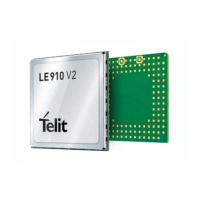Telit LE910 V2 Series AT Commands
80446ST10707A Rev. 0– 2015-11-03
Reproduction forbidden without Telit Communications S.p.A. written authorization - All Rights Reserved page 20 of 509
Mod. 0808 2011-07 Rev.2
A string, either enclosed between quotes or not, is considered to be a valid string type parameter
input. According to V25.ter space characters are ignored on the command line and may be used
freely for formatting purposes, unless they are embedded in numeric or quoted string constants;
therefore a string containing a space character has to be enclosed between quotes to be
considered a valid string type parameter (e.g. typing AT+COPS=1,0,”A1” is the same as typing
AT+COPS=1,0,A1; typing AT+COPS=1,0,”A BB” is different from typing AT+COPS=1,0,A
BB).
A string is always case sensitive.
A small set of commands requires always to write the input string parameters within quotes: this
is explicitly reported in the specific descriptions.
3.2.2. Command Lines
A command line is made up of three elements: the prefix, the body and the termination
character.
The command line prefix consists of the characters “AT” or “at”, or, to repeat the execution of
the previous command line, the characters “A/” or “a/” or AT#/ or at#/.
The termination character may be selected by a user option (parameter S3), the default being
<CR>.
The basic structures of the command line are:
• ATCMD1<CR> where AT is the command line prefix, CMD1 is the body of a basic
command (nb: the name of the command never begins with the character “+”) and <CR> is
the command line terminator character
• ATCMD2=10<CR> where 10 is a subparameter
• AT+CMD1;+CMD2=, ,10<CR> These are two examples of extended commands (nb: the
name of the command always begins with the character “+”
2
). They are delimited with
semicolon. In the second command the subparameter is omitted.
• +CMD1?<CR> This is a Read command for checking current subparameter values
• +CMD1=?<CR> This is a test command for checking possible subparameter values
These commands might be performed in a single command line as shown below:
ATCMD1 CMD2=10+CMD1;+CMD2=, ,10;+CMD1?;+CMD1=?<CR>
anyway it is always preferable to separate into different command lines the basic commands and
the extended commands; furthermore it is suggested to avoid placing several action commands in
2
The set of proprietary AT commands differentiates from the standard one because the name of each of them begins with
either “@”, “#”, “$” or “*”. Proprietary AT commands follow the same syntax rules as extended commands

